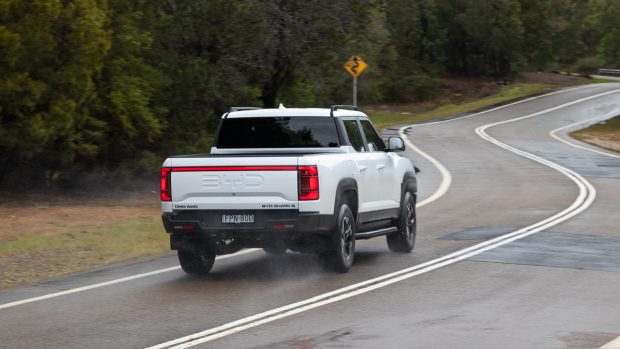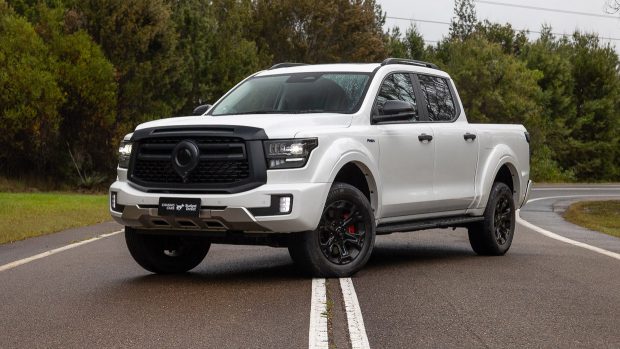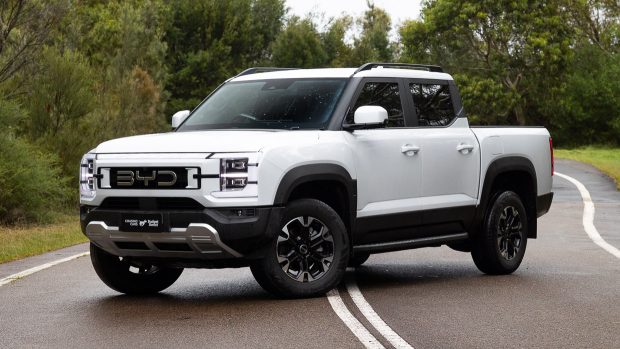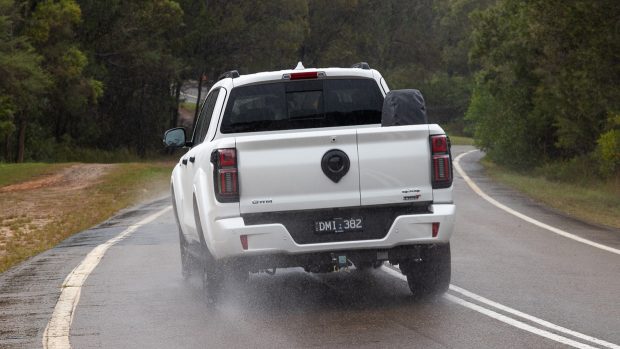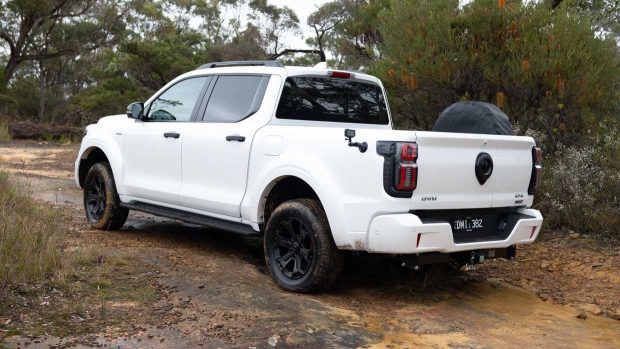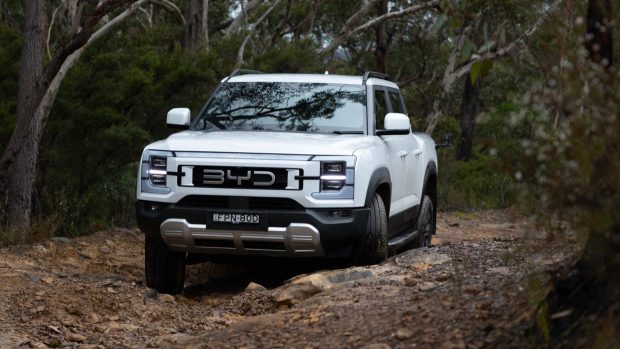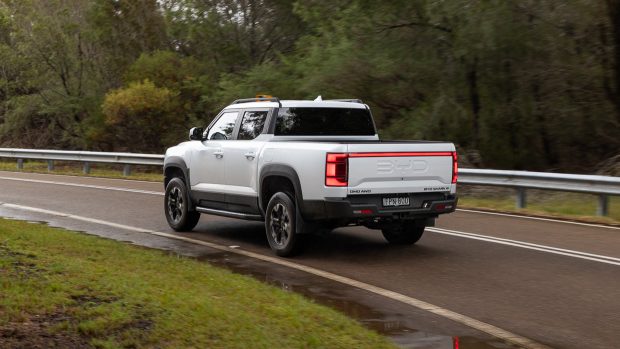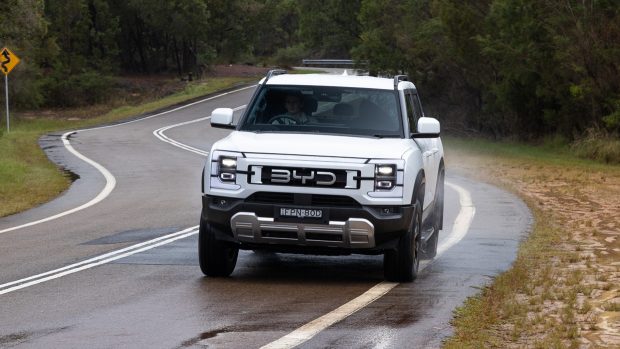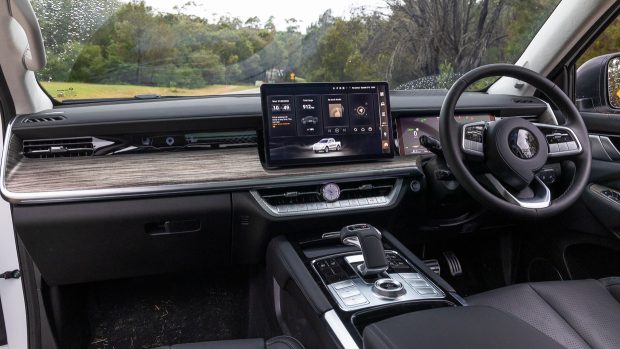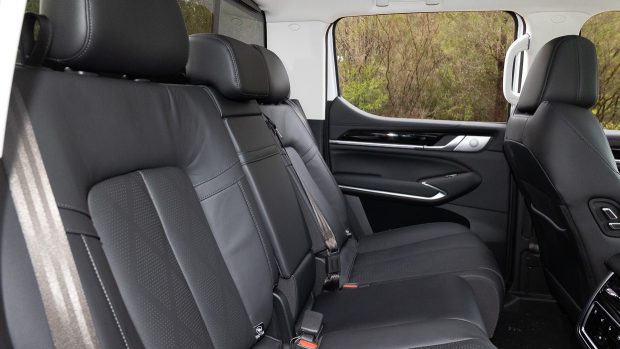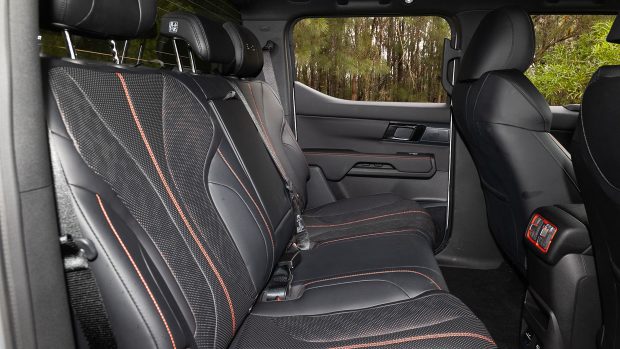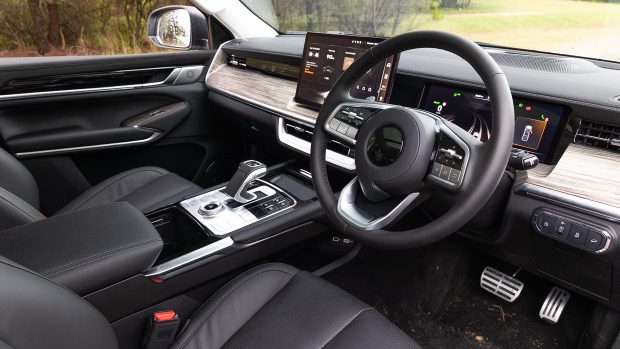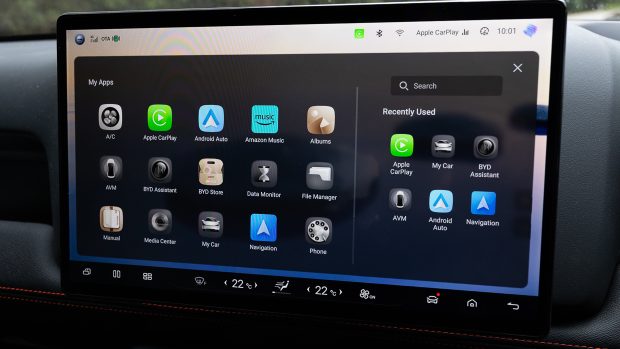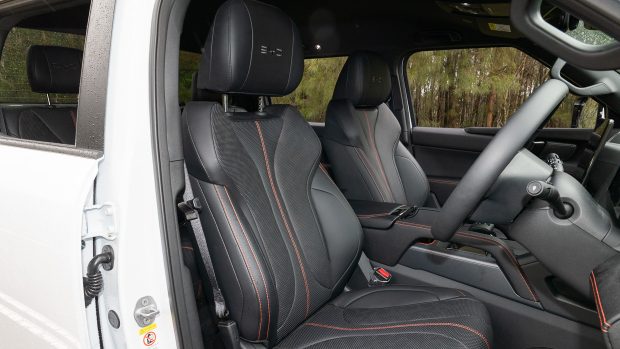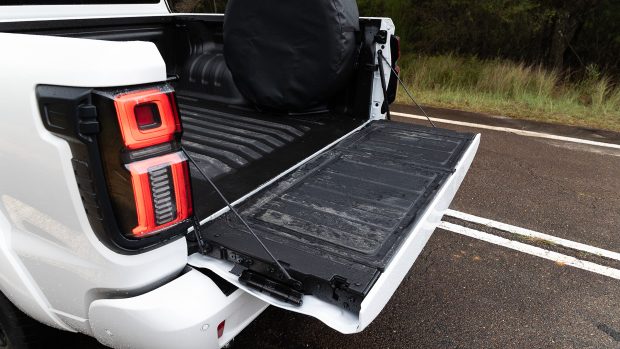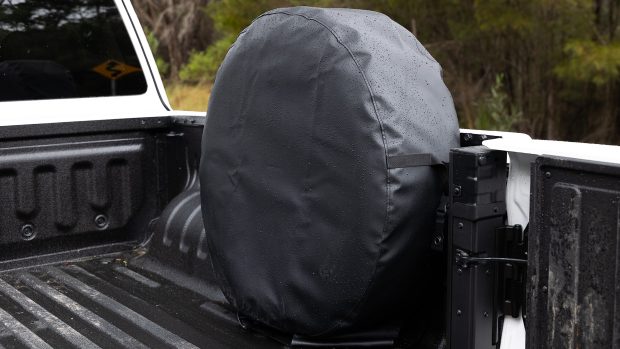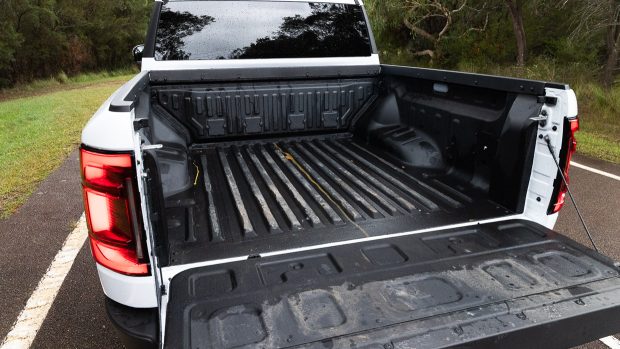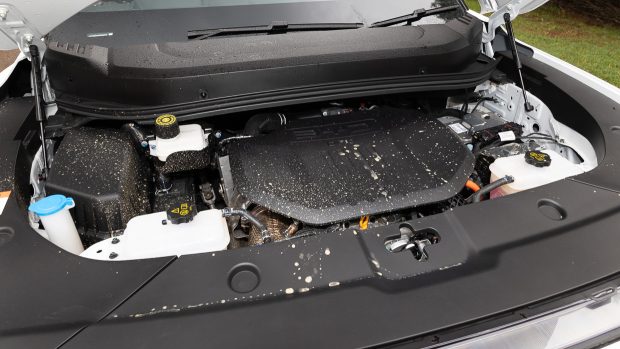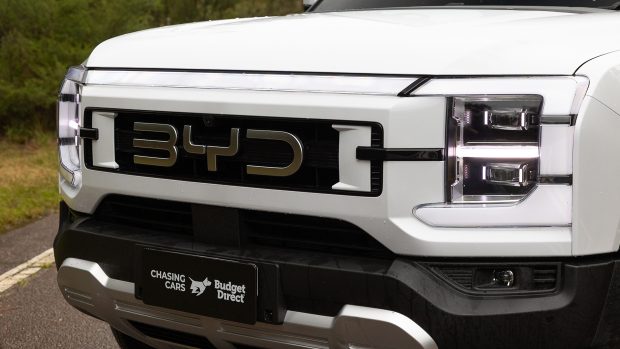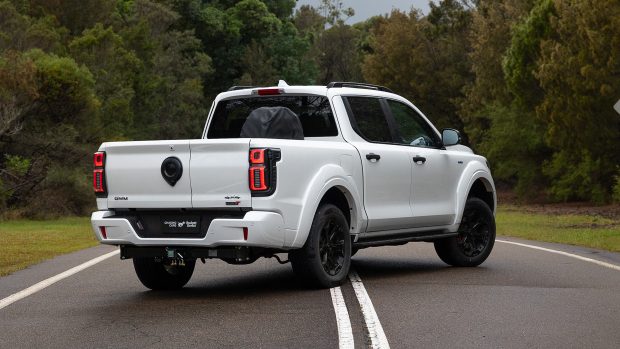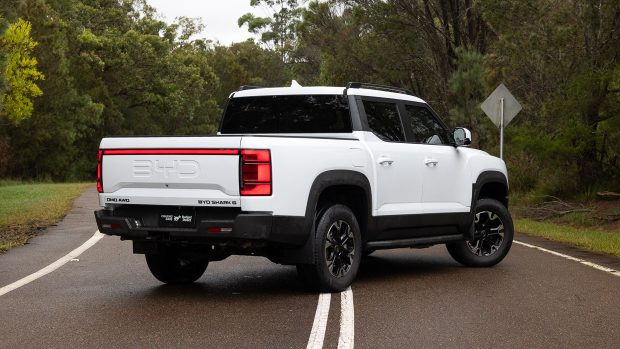-
Car Reviews
- All reviews
- Midsize SUVs
- Small cars
- Utes
- Small SUVs
- Large SUVs
- Large cars
- Sports SUVs
- Sports cars
- Vans
Latest reviews
- Car News
-
Car Comparisons
Latest comparisons
- Chasing Deals
A plug-in ute grudge match with two new faces from China. Is the BYD Shark 6 or GWM Cannon Alpha better?
It’s a funny world we live in, because just five years ago the idea of Chinese-built petrol plug-in hybrid dual-cab utes challenging established names such as Ranger and Hilux for supremacy would have been laughable.
Yet here we are, with the BYD Shark 6 taking Australia by storm despite lacking inviolable features such as a 3.5-tonne towing capacity, a true 4×4 system, and one-tonne payload.
Sure it isn’t outselling the top two, but BYD only currently offers one, high-spec, lifestyle-oriented trim and it’s putting heat on the Isuzu D-Max, Nissan Navara and Mitsubishi Triton.
In steps a more established Chinese brand with more ute experience, GWM, with its biggest and baddest rival yet, the Cannon Alpha. Available already in diesel and plugless hybrid guises, the plug-in we have on test is here to unapologetically hit the BYD where it hurts.
That means a 3500kg braked towing rating, a traditional 4×4 set-up with low-range transfer case, and up to three differential locks. The writing’s on the wall, then? Not quite…
We’ll tackle the Cannon Alpha first as it’s the newcomer. GWM is offering the plug-in hybrid in two trims, entry Lux ($59,990) and top-spec Ultra ($66,990), as we have here.
At the time of review, GWM had both on a limited-time offer (through to the end of September 2025) at $57,490 and $64,490 respectively, driveaway.
You pay a hefty $12,500 premium for the Ultra plug-in hybrid over the diesel ($54,490) but it delivers some stellar stats: 300kW and 750Nm, 115km electric driving range (NEDC), plus luxury features such as power-reclining rear seats, heating and ventilation for four positions, a sunroof, and more.
Even though the BYD’s headline figures look a little less impressive, with a smaller battery delivering 100km of electric range (NEDC) and torque down at 650Nm, it has plenty of power (321kW) and similar levels of equipment for a more attainable price of $57,900, before on-road costs, or around $61,510 driveaway. BYD did offer a limited $4000 cashback offer that expired at the end of July 2025.
The Shark’s customisation is limited at the dealer, with only four colours including our cars tested Great White plus the new non-nautical Outback Orange.
We spent extensive time driving the Cannon Alpha PHEV and GWM Shark 6 on and off-road to split these two — we even put this pair through a trio of challenges, which you can watch here in the video version of this review.
For the main comparison, we’ll cover each more generally, starting with the Cannon Alpha. Its urban manners are pretty impressive, with a plush ride thanks to soft coil springs. It doesn’t have any clever adaptive dampers, and features double-wishbone front and multi-link rear suspension with a live axle.
The Cannon Alpha PHEV has a lot more grunt than the diesel, but we found the amount of performance to be unnervingly variable in the real world. Sometimes a full bootful would conjure up what felt like 750Nm, yet other times it would be a much limper experience than the spec page suggests.
We wonder if this is down to the drivetrain configuration (a 120kW electric motor drives through the nine-speed automatic transmission) or calibration.
Having sampled other manufacturers’ similar plug-in hybrid set-ups (from BMW, Mercedes-Benz, Volkswagen, et al) we suspect another round of tuning and refinement would go a long way in improving the Cannon Alpha’s drivability.
The same is true at speed on the country roads, where the wallowy Cannon Alpha is all at sea. A very soft spring and damper tune means the GWM lacks body control and precision. It also feels disconnected front-to-rear, with each end reacting differently to bumps and corners. This is only amplified with a load in the tray.
Strong brakes (four-wheel discs and regeneration) add a bit of confidence back into the mix, but we also found the Cannon Alpha to be loud on the road, with plenty of tyre noise breaking the serenity in the cabin.
The Alpha’s drivetrain layout does have one big benefit, though, giving the GWM stellar off-road ability. Before we get to hardware, the traction control software is expertly tuned. Thanks to good axle articulation, the GWM cruises up gnarly climbs.
More technical sections can be dispatched with the centre, rear and even front (Ultra-only) differentials locked, while low-range makes for easy power modulation.
| Specification | BYD Shark 6 | GWM Cannon Alpha |
| Approach angle | 31 degrees | 28.5 degrees |
| Departure angle | 19.3 degrees | 19 degrees |
| Breakover angle | 17 degrees | 23 degrees |
| Ground clearance | 230mm | 210mm |
| Wading depth | 700mm | 800mm |
The Shark 6 was shown a clean pair of heels in our rock-crawl test. It really struggled, actually, which is a big chink in the BYD’s armour. Some claim the Shark 6 is more effective off-road with its traction control disabled, but that rather defeats the purpose of the driver aids. We hope BYD adds a better variant in time.
Basically, having double-wishbone suspension all around that’s more set-up for driving at speed than rock-crawling, a poorly calibrated traction control system (no matter which of modes you choose) and no locking diffs axes the Shark’s all-road ability.
It’s a shame, because having sampled what BYD can do with the Denza B5 and B8’s locking diff-equipped drive systems, we know that the Chinese brand could level up the Shark 6’s ability. Let’s hope that happens.
We’ll get the other negative out of the way, too, the on-road ride quality. It’s firm — sportscar firm, actually — with lots of damping control and stiff springs. The Shark 6 is, therefore, a little tiring on broken urban tarmac, but once you have some speed up things improve markedly. And while the Shark 6 is firm, it’s never crashy like Hiluxes and D-Maxes can be.
The rest of the time, the Shark 6, it’s a far more polished, consistent and rewarding ute to drive than the Cannon Alpha. Crisp throttle response, better brake pedal, a steering wheel with weight behind it, and a body that resists roll. Plus, leaning more on electric motors makes for a quieter drive.
The Shark 6 employs two e-motors, one at the back (150kW) and another at the front (170kW). The front axle also occasionally draws power from the 1.5-litre turbo-petrol four-cylinder to reach peak power. Otherwise, it runs as a generator for the battery.
When at full noise, it’s quite easy to believe the Shark 6’s Ranger Raptor-beating 5.7-second 0-100km/h claim — it’s properly rapid. No wonder our dyno testing returned an indicated 1000Nm at the wheels.
You might have noticed an anomaly with the motor biassing, being that there’s more grunt available at the Shark 6’s front axle. This translates to a unique phenomenon in dual-cab world of front wheelspin in slippery conditions — even despite the Shark 6’s higher quality Continental tyres versus the Cannon’s cheap Gitis.
Subjectivity will play a big part in which cabin you prefer as the Cannon Alpha Ultra and Shark 6 go about interiors in very different ways. The GWM leans into a luxury aesthetic more reminiscent of the defunct Mercedes-Benz X-Class, while the BYD is more conventional in its cabin detailing.
With a light headliner, faux woodgrain trim, sunroof, and Rolls-Royce-aping centre timepiece (that’s rather plasticky), the Cannon isn’t what you’d call rough and tumble even if the build quality is mostly impressive.
There’s a veneer of luxury presented in this way, but it quickly falls away when you interact with major touchpoints, like the thin-rimmed wheel and plasticky centre console controls.
The Cannon Alpha PHEV has the same 14.6-inch touchscreen you’ll find in the diesel and hybrid variants which supports wireless Apple CarPlay and Android Auto, just like the BYD. Neither system is the height of user-friendliness, with lots of menus and sub-menus to wrap your head around.
There are, at least, a few physical switches near the Cannon Alpha’s jet fighter-like shifter, including hard buttons for seat heating and ventilation, differential locks, and drive modes.
GWM’s seats have come a long way since the early Cannons and Haval H6s to be quite comfortable, with ample electric adjustment for driver and passenger. Apparently real leather-accented, the Cannon Alpha’s upholstery felt similar in quality to the Shark 6’s synthetic leather.
The rear seat is large for an ute, and that sunroof plus easy-to-mark white headliner makes it an airy, breezy place to sit. Power-adjust for the second row is a nice, if fairly pointless, luxury. More useful ones include heating and ventilation for outboard passengers, air vents, and USB charge sockets.
Plus, because the Cannon Alpha’s back rest is split into three, 40/20/40 segments, it’s a far more user-friendly vehicle to put child seats into. The BYD’s backrest is, painfully, all one piece.
The rear of the Shark 6 is also less accommodating, with less space, poorer visibility out and no ventilation or power adjustment. It does the job well enough for adults under 180 centimetres, though, equalling the Cannon Alpha’s vents and charge sockets but levelling up with a household plug.
In the front, the GWM may feel solid in some areas, but the Shark 6’s cabin is cohesive and impressive on the whole. From the sturdy, thick-rimmed steering wheel with easy-to-use drive mode scroll wheels to orange flourishes in the stitching and on the vents, it hits what people want.
Like the Cannon Alpha, the Shark’s multimedia is a little busy — and doesn’t make sense in portrait mode — at first, but you become accustomed to it. The layout seems a whisker friendlier than the GWM’s, too.
The centre console has a funky, symmetrical design with chunky, gloved-hand operable switches for the hazard lights, EV/HEV selection, and start-stop button. ESC, and front demister. A scrolling volume dial and other buttons allow easy interaction with the ESC and front demister.
Compared to the Cannon Alpha’s squishy seats, the BYD’s chairs are supportive and more European, giving solid all-day comfort behind the wheel. The driver gets four-way lumbar adjustment, but the passenger misses out. Heating and ventilation is standard, too.
Both utes have much better sound systems than you might expect, though neither takes a clear lead in these stakes. For cohesion and quality, the BYD Shark 6 is the in-cabin clear winner.
The two utes trade blows with on-paper measurements, but the real-world packaging of the GWM’s full-size spare in the tray is a compromised solution. Plus, the larger battery pack sees the tray’s floor raised in the centre, further hurting useability. See the table below for measurements.
| Measurement | BYD Shark 6 | GWM Cannon Alpha PHEV |
| Length | 1520mm | 1500mm |
| Width | 1500mm | 1520mm |
| Between the arches | 1200mm | 1100mm |
| Depth | 517mm | 500mm |
| Payload | 790kg | 685kg |
The GWM’s split tailgate seems like a clever idea, improving access for loading. The implementation leaves room for improvement — the tailgate feels flimsy and our car’s operation was buggy. We even managed to open it in three dimensions a few times.
And if you run the spare tyre in the boot, forget being able to fit a tonneau cover — hard or soft — to the Shark 6 PHEV.
The BYD has no such issues with its similarly-sized load bay. A lighter kerb weight pays dividends with a greater payload, even if the Shark 6 can’t match the Cannon Alpha’s 3500kg braked towing capacity.
Both cars have tie-down points in the back, bright lights, and spray-in bedliners. The Shark 6’s liner is open at the cabin end, though, meaning you’ll get dirt in there that’s almost impossible to clean.
It does have a trio of 230-volt three-pin sockets and a fully-flat load bay, meaning the Shark 6 is the more useful of these two ute in the real world.
The GWM Cannon Alpha PHEV and BYD Shark 6 both scored five stars in their ANCAP safety tests, performed in 2024 and 2025, respectively.
Both utes are fitted with all the modern safety aids you would expect, including auto emergency braking (AEB), blind-spot monitoring, lane-keep assist, driver-attention monitoring, speed limit assist, and adaptive cruise control.
Impressively, the Shark 6 and Cannon Alpha PHEV were both quite agreeable when it came to the tuning of the systems. The lane-keep assist could be a little tiresome in the Cannon Alpha, but ultimately these two brands have come a long way in terms of tuning.
That’s a doubly good thing, because turning off lane-keep, speed limit assists and other perennially annoying systems requires a lot of touchscreen tapping in both vehicles.
| Category | BYD Shark 6 | GWM Cannon Alpha |
| Airbags | 7 | 7 |
| Adult Occupant Protection | 85% | 84% |
| Child Occupant Protection | 87% | 93% |
| Vulnerable Road User Protection | 74% | 82% |
| Safety Assist | 86% | 81% |
| Overall ANCAP score | 5 stars (2025) | 5 stars (2024) |
Plug-in hybrid vehicles are wondrous on paper. In the case of the Shark 6 and Cannon Alpha, the specs reveal 2.0L/100km and 1.7L/100km, respectively, scores better than your average diesel dual-cab ute that will return closer to 8.0L/100km in the same, combined, NEDC run.
They both boast pretty stellar electric-only ranges, too, with the BYD promising 100km (and delivering about 80km, really) and the Cannon Alpha matching its 115km claim in the real world. Impressive.
Yet go beyond the 115km figure and the sheer weight (2710kg for the Shark 6 and 2810kg for the Cannon Alpha) have their small four-cylinder motors working overtime.
The result? A thirsty pair when driving on open roads, and limited touring range. We’ll start with the Shark, which drank 95RON at 8.2L/100km at the bowser on our 350km test loop along with consuming all 29.6kWh of its battery. That’s a 732km combined driving range, compared to the 800km claim.
Over in the heavier GWM camp, things are even thirstier. The Cannon Alpha returned 9.9L/100km on the same loop, meaning its bigger 75-litre fuel tank and much larger 37.11kWh battery (both use less volatile lithium-iron phosphate chemistry) will take you 758km on the first fill up.
Those figures are comparable, if not slightly worse, than diesel dual-cab utes like the Ford Ranger and Toyota Hilux. In urban environments with regular top-ups, though, both utes are quite impressive at getting around on electric-power alone — though the BYD remains the pick for this.
A bonus for these two Chinese rivals (compared to the Ford Ranger PHEV, specifically) is the ability to fast-charge at DC pylons. The GWM claims 50kW, a little slower than the BYD’s 55kW peak.
A real-world test revealed the Cannon Alpha was actually slightly faster to charge, taking on 15.5kWh in 23 minutes compared to the BYD’s 12kWh in 34 minutes.
Servicing is due every 12 months or 15,000km for the Cannon Alpha PHEV and it will cost you a steep $4615 over that time. GWM covers all of its vehicles with a seven-year/unlimited kilometre warranty in Australia.
Meanwhile, the Shark 6’s warranty is slightly worse at six years and 150,000km but servicing is cheaper ($3296 over seven years) and due less frequently (12 months/20,000km) plus there’s a guide on BYD’s website that shows capped-price servicing up to 11 years.
If you listen to the marketing material and judge the Cannon Alpha purely on its ability to beat the Shark 6 ‘where it counts’, the Ultra PHEV delivers. Off-road capability is stunning and you can’t argue with a 3500kg braked towing certification.
Holistically, though, the Cannon Alpha plug-in falls short. An interior that’s, weirdly, more focused on luxury than offering practical solutions to back-up off-road nous, for example.
Ultimately it’s the GWM’s lacklustre packaging, plus sloppy drivetrain and chassis calibration that lets it down against the Shark 6.
6.5/10
Good Points
Needs Work
The Cannon Alpha almost had the Shark 6 on the ropes when it came to rock-crawling, which is so clearly not the BYD’s strength. Double-wishbone suspension, poor articulation and no locking diffs sees to that.
But as a complete package? The Shark 6 has it. We’d love to see some running recalibration on the powertrain responses and firm ride quality, but against the Cannon it’s already a much more complete package with a modest asking price.
From a brand that’s not known for its ute prowess, the Shark 6 is a smart product that backs away from trying to do it all well, and provides excellent tarmac and dirt-road manners.
8.5/10
Good Points
Needs Work
Latest comparisons
About Chasing cars
Chasing Cars reviews are 100% independent.
Because we are powered by Budget Direct Insurance, we don’t receive advertising or sales revenue from car manufacturers.
We’re truly independent – giving you Australia’s best car reviews.
